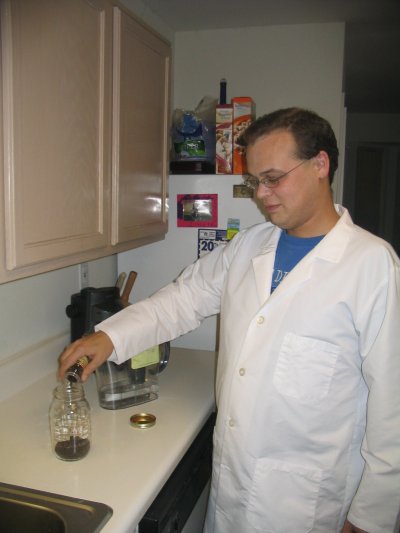Taking spice in another direction
![]() Our pear infused vodka experiment is complete, but we have not been able to make time for a tasting as of yet. We'll have that ready very soon, but in the meantime, we have started another experiment: pepper vodka, or to be specific, peppercorn (black pepper) vodka. In the past, we have spiced up our vodka with jalapeños and even habaneros; this time, we decided to try the more traditional flavor of pepper vodka.
Our pear infused vodka experiment is complete, but we have not been able to make time for a tasting as of yet. We'll have that ready very soon, but in the meantime, we have started another experiment: pepper vodka, or to be specific, peppercorn (black pepper) vodka. In the past, we have spiced up our vodka with jalapeños and even habaneros; this time, we decided to try the more traditional flavor of pepper vodka.
Peppercorns are wholly unrelated to chile peppers, and contain none of the capsaicin chemical that makes jalapeños and habaneros spicy. Instead, they contain the chemical piperine, which is about one-hundredth as pungent as capsaicin. Still, it has an impressive flavor and bite, so long as it is fresh. The flavor of peppercorn is greatly reduced by evaporation, which is why freshly ground pepper from a pepper mill is so much more flavorful than pre-ground pepper.
Wayland began by pouring a layer of peppercorns into a science jar. We didn't really measure them; we just put in enough to cover the bottom of the jar.
We had to remove the lid from the peppercorn bottle to get them out. We were amused that the lid was designed to shake them out, but none of the holes were large enough for a peppercorn to fit through them.
Most of the peppercorns remained at the bottom once vodka was added, though some of them floated and one lone wolf decided to hover somewhere in the middle.
We don't expect this one to take particularly long. Stay tuned for the results of the pear vodka, to soon be followed by an update on the pepper experiment.

9 comments:
I feel I should warn you...this one's been pretty well done, by sources such as Alton Brown on Good Eats. And one important factor, according to Brown, is that the peppercorns should be cracked before the infusion begins.
Here's the link...
What factors do you consider when determining the length of the infusion?
And have you ever considered infusing with frozen fruits?
We predict the length of an infusion based on past experience - for example, pear is likely to take about the same amount of time as apple - and by researching online to see how others have done it before. If there is uncertainty, we usually guess low, and taste the infusion periodically. When it tastes good, it's done.
As for frozen fruits, we've never tried it, but we'll keep it in mind for future experimentation!
I used some cracked extra-spicy sichuan black peppercorns and mine was quite spicy after 9 days
Have you guys considered trying grapefruit vodka?
Update!!!!!!!!!
I'm an actual scientist and I do similar stuff in my actual lab (fruit extractions). Your methods show a lack of understanding of what the processes involved here (basically diffusion and osmosis). The flavour compounds in your food can only dissolve into the vodka if they come into contact with the vodka, yet you use uncracked peppercorns or whole grapes with two tiny whole in them and your fruit is in big chunks rather than broken up properly. How is the flavour supposed to diffuse out?
Your results would be so much better if you actually crushed your fruit or spices and just filtered the vodka afterwards (screen printing mesh makes an excellent, cheap filter). You need to increase the surface area of plant matter exposed to the vodka. Fruit skin often has interesting flavour and aroma compounds in it so it makes sense to include it, but they are also usually pretty impermeable to liquid so at the very least you need to peel your fruit so the insides are exposed (cracking peppercorns is a similar example). Slicing the fruit then crushing it roughly with the flat of a knife would be the most efficient way or preparing it.
Flavour compounds are volatile, they'll dissolve pretty well into your vodka given the chance. But they are also stuck fairly well inside the plant's cells and don't diffuse through solid fruit. This is why yours is taking so long, the fruit needs to start breaking down before the good stuff is are released and by then you're getting flavour degradation plus some off flavours from the damaged fruit (how much of that last part happens probably depends on the type of fruit). Breaking up the fresh fruit yourself would burst the cells, releasing the flavours without waiting for the fruit to decay.
The flavour compounds also break down fairly readily so you're likely to get fresher, better flavours if you speed up the process rather than slow it down. Dark and cool is the right approach (light and heat destroy the compounds you're trying to capture), so as well as keeping them in the fridge I'd be wrapping each jar in aluminium foil. Gentle agitation would also help speed up the process but probably isn't necessary.
FWIW I get a great infusion after two hours agitation only - not days or weeks. Kiwifruit, in particular, gives a wonderful green colour. My solvents are more pure (95% food grade ethanol or distilled water) but I think it's the procedure that's making the main difference. A simple change to your method could cut your waiting time down to days and it'll taste better too.
Did you guys die again? 'Cause that would suck..
@Scott,
And yet we live...
Post a Comment